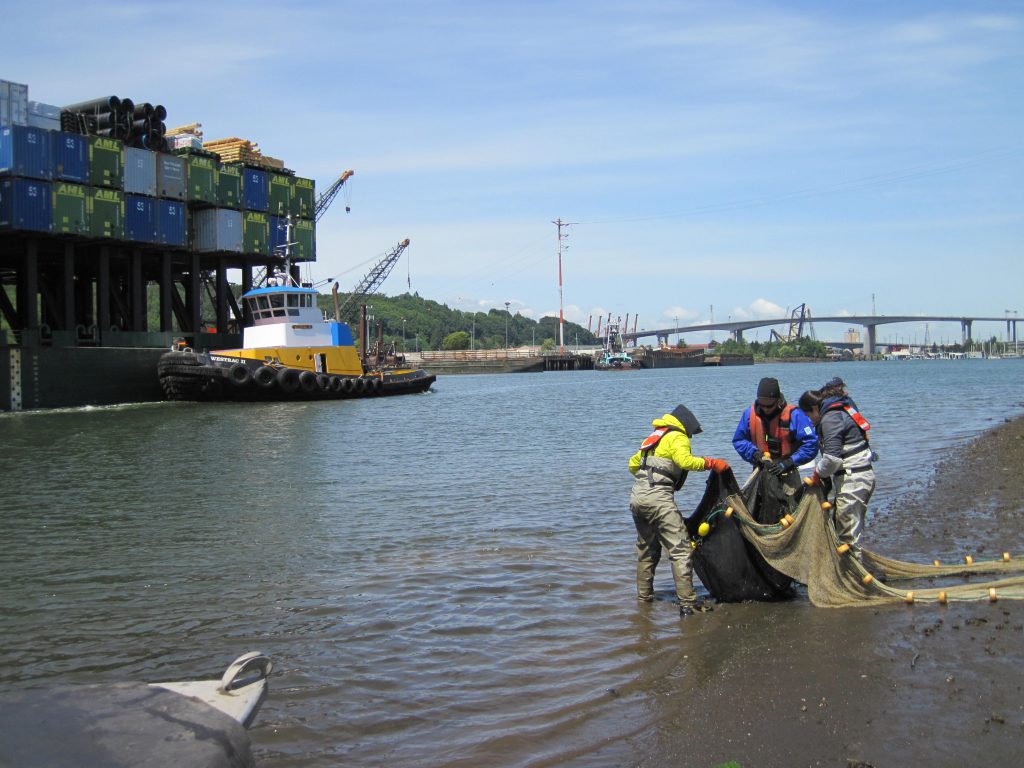
Toxic chemicals in Puget Sound and the surrounding environment affect aquatic animals throughout the region. These chemicals can affect water quality and degrade habitat. Many of these chemicals can harm people who eat contaminated Puget Sound seafood, with outsized effects on groups of people who rely on Puget Sound seafood.
The Puget Sound Vital Signs measure ecosystem health, and one of those Vital Signs monitors toxic chemicals in aquatic animals. The Toxics in Aquatic Life Vital Sign tracks four pollutant groups and the level of contamination in four Puget Sound species—salmon, mussels, English sole, and herring.
The pollutant groups include:
- PCBs (polychlorinated biphenyls, formerly used in hundreds of industrial applications);
- PBDEs (polybrominated diphenyl ethers, flame-retardant chemicals used in furniture, mattresses, and electronics);
- PAHs (polycyclic aromatic hydrocarbons, found in creosote-treated wood, combustion of fossil fuels, sealants, and petroleum products like oil and diesel); and
- CECs (contaminants of emerging concern, found in pharmaceutical and personal care products and industry and business products).
These groups include both chemicals that stay in the ecosystem for a long time and others that break down in the environment.
Jim West, senior research scientist with Washington State Department of Fish and Wildlife’s (WDFW) Toxics Biological Observation System (TBiOS), which is the lead reporter for the Vital Sign, explained why Toxics in Aquatic Life focuses on specific species and contaminants. “The concept is to break up the ecosystem into manageable habitats, so that we can talk about recovery in major habitats. And we have indicator species that represent each of those—for instance, we have an indicator species for the benthic habitat, that is, for animals that live on or in the sea floor, for nearshore habitats, for open water habitats and for river habitats. We’re ultimately looking at the health of those organisms and the people that consume them.”
West also explained that the Vital Signs tracks major classes of contaminants—out of tens of thousands of possible chemicals—because we can take specific actions to reduce the occurrence of those major groups. “For example, we have chemicals that map back to stormwater, and chemicals that map back to wastewater,” he said. “And there are actions we can take to reduce all those chemicals.”
The 2022-2026 Action Agenda, our community’s shared four-year plan for recovering Puget Sound, sets targets for six Puget Sound Vital Signs, including Toxics in Aquatic Life. There are two targets for the Toxics in Aquatic Life indicators:
- By 2030, 95 percent of the samples gathered across Puget Sound habitats exhibit a declining trend of contaminant levels, or are below thresholds of concern for species or human health.
- By 2050, 95 percent of the samples gathered across Puget Sound habitats exhibit contaminant levels below thresholds of concern for species or human health and show no increasing trends.
West said that meeting these targets would represent huge progress for both the health of fish and other wildlife species and people—and a lot of that has to do with the concepts of bioaccumulation and biomagnification.
West explained that many contaminants are bioaccumulative, which means that they remain in a fish’s tissues and affect that fish. But as West said, with biomagnification, that means that, “When a herring builds up PCBs in its tissues, that’s going to impact the herring. But what about the Chinook salmon that eats 10,000 herring over its lifetime? All those chemicals stay in the salmon. And then with the Chinook salmon, what about the killer whale that eats a thousand Chinook salmon in its lifetime? [If we achieve these targets], we will interrupt the movement of these chemicals by cutting them off at their source, which should result in better birth rates and survival for these species.”
Louisa Harding, junior research scientist with the TBiOS program, said that she thinks about the targets in the context of stressors that affect Puget Sound fish species. “In addition to contaminants, they have to face things like changes in temperature and disease that in combination can lead to adverse health outcomes or death,” she said. “And we might not be able to reduce all those stressors, but if we can reduce contaminant exposure, the fish have a better shot at survival and being able to thrive.”
Dan Stonington, planning manager with the Puget Sound Partnership, explained that the Vital Sign indicator targets are an important component of the Action Agenda. “These targets are essential. They will help us understand whether we are making long-term progress toward our statutory goals.”
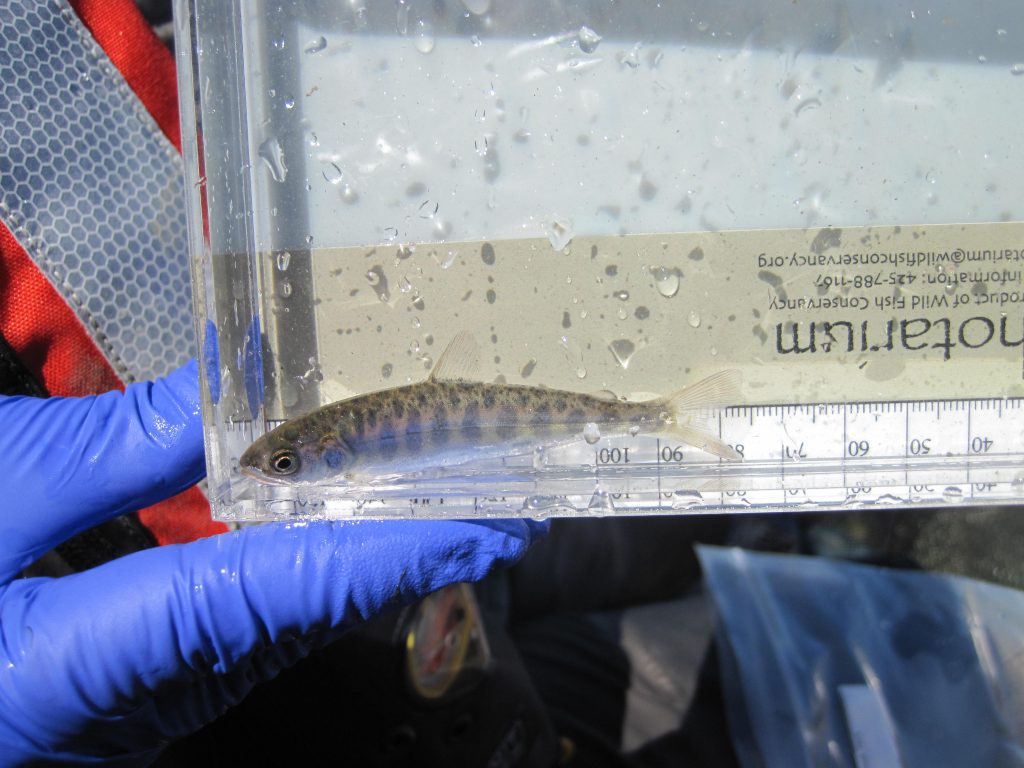
Reducing toxics in aquatic life is good for the ecosystem and good for people
Reducing contaminants in the Toxics in Aquatic Life indicator species—salmon, mussels, English sole, and herring—will help those species grow, reproduce, and in time attain healthy and sustainable populations. And as West and Harding mentioned, reducing those contaminants and stressors will improve the health of other species and habitats throughout the Puget Sound ecosystem.
Andrea Carey, a biologist with the TBiOS program whose work focuses on salmon, spoke about how an improvement in the health of Chinook salmon would have widespread effects on other species and people. “They’re such an integral part of the Puget Sound food web,” she said. “Reducing contaminants in salmon is beneficial for the ecosystem and to the humans who live around and visit Puget Sound. Healthy salmon populations could result in more fishing opportunities for recreational, commercial, and tribal subsistence anglers, and salmon are important for tribal cultural practices. Healthy salmon would mean the animals, like the Southern Resident killer whales and seals that eat salmon will be healthier and less at risk of health effects caused by contaminant exposure. More healthy salmon is good for the whole ecosystem.”
For people who rely on Puget Sound seafood, high levels of contaminants in aquatic life threaten their livelihoods and their traditions. Approximately 35 percent of Puget Sound residents harvest local fish or shellfish, and contaminants in aquatic life limit the amount of seafood that people can safely eat.
West said they are becoming more aware of inequitable health effects related to contaminated seafood, and he hopes to be mindful of these inequities as they modify existing monitoring or design future studies. He highlighted a paper by Jamie Donatuto, environmental health analyst with the Swinomish Indian Tribal Community, “Poisoning the body to nourish the soul: Prioritizing health risks and impacts in a Native American community,” a study that shows how “to eat less seafood (as prescribed on the basis of current physiological measures) may actually be detrimental to the Swinomish concept of health.”
“The tribe’s concept of health is different from non-Indigenous notions of health,” West said. “Their concept of health includes consuming Puget Sound seafood at a level that satisfies multiple dimensions of their health-concept, satisfying spiritual and cultural needs, yet might at the same time be ‘poisonous’ to their bodies. They’re nourishing their souls by using this resource. That’s made us sit up and ask questions about who’s being impacted by contaminants in ways we hadn’t necessarily considered before.”
Collecting samples throughout Puget Sound with partners
The TBiOS program works with many partners to collect samples of the indicator species to analyze. While the TBiOS team and other WDFW staff collect juvenile and adult salmon, English sole, and herring, they can’t be everywhere at once, as West said, and don’t have the resources to collect samples all the time.
“For the mussel monitoring, we put out a hundred cages of mussels over a week period,” West said. “How do we do that? Our mussel team has a network of volunteers—environmental groups, local agencies, the Seattle Aquarium, and others.”
TBiOS also works with many of the tribes in the Puget Sound region to collect seaward migrating juvenile salmon. “There are so many river systems that empty into Puget Sound, and we’re just a small group that can’t cover such a large geographic area,” Carey said. “With these big projects, [tribes] have been really receptive—they’re great stewards of the environment and we benefit from their knowledge. In the spring, they’ll collect juvenile Chinook salmon for us and then we share our data with them.”
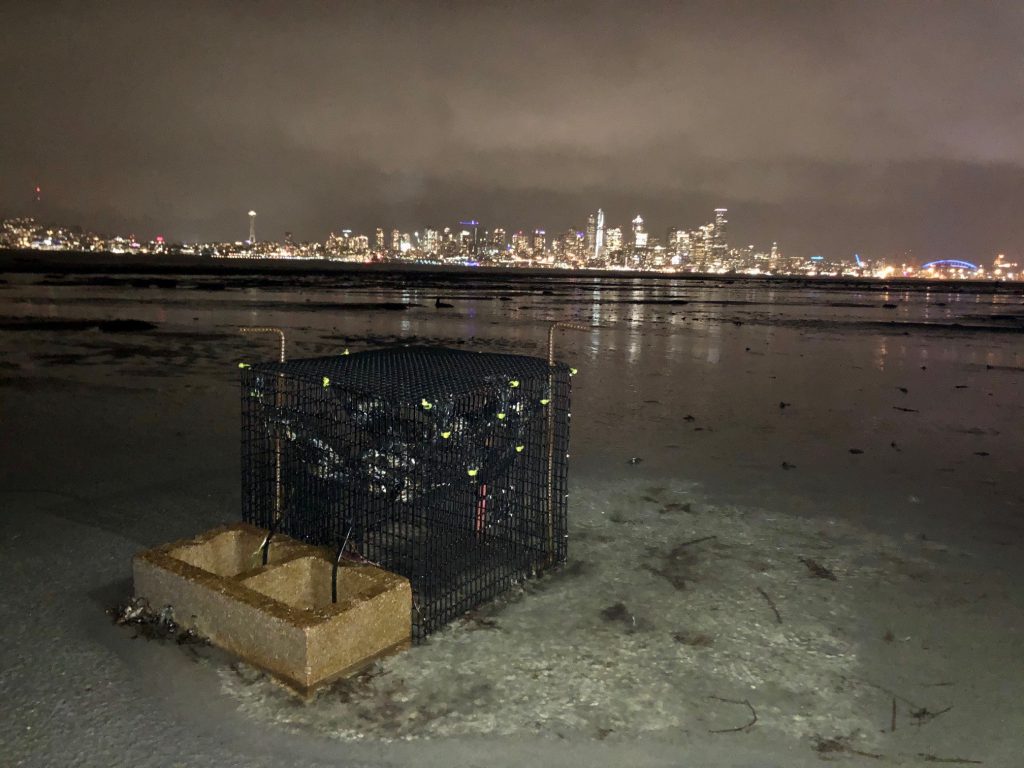
The current state of toxics in aquatic life
Current monitoring and research shows that toxics-related fish and human health issues in Puget Sound are persistent and many contaminants are widespread.
PCBs—which West called “the most worrisome chemical” they monitor—remain a problem in the region despite the fact these chemicals were banned more than 40 years ago. According to the EPA, PCBs were used in hundreds of applications, including electrical and hydraulic equipment, plasticizers in paints, plastics, and rubber products, and in pigments, dyes, and carbonless copy paper. Monitoring has shown high levels of PCB contamination in all four habitat regions of Puget Sound and levels of PCB contamination have increased in some urban seafloor habitats.
Although there have been reductions in PBDEs and PAHs in some areas, these chemicals and CECs remain at levels that are harmful to other aquatic life. Some CECs in particular are endocrine-disrupting chemicals, which means they can change an organism’s hormones and affect reproduction, growth, and development. These CECs often mimic estrogen, which can change the timing of reproduction for adult female fish and produce female-specific characteristics in male fish. This effect has been especially apparent in Puget Sound English sole.
“Our current research is showing that male English sole from a variety of locations throughout Puget Sound are expressing this protein called vitellogenin,” Harding said. “Vitellogenin is normally only produced by female fish because it’s a protein that’s involved in producing egg yolk. In males it’s a totally useless protein—they’re not making eggs so they have no use for it. But if male fish are exposed to estrogen or estrogen-like compounds, they’ll produce it in the same way. So we can use that as a marker of where fish are being exposed to chemicals that can mimic estrogen.”
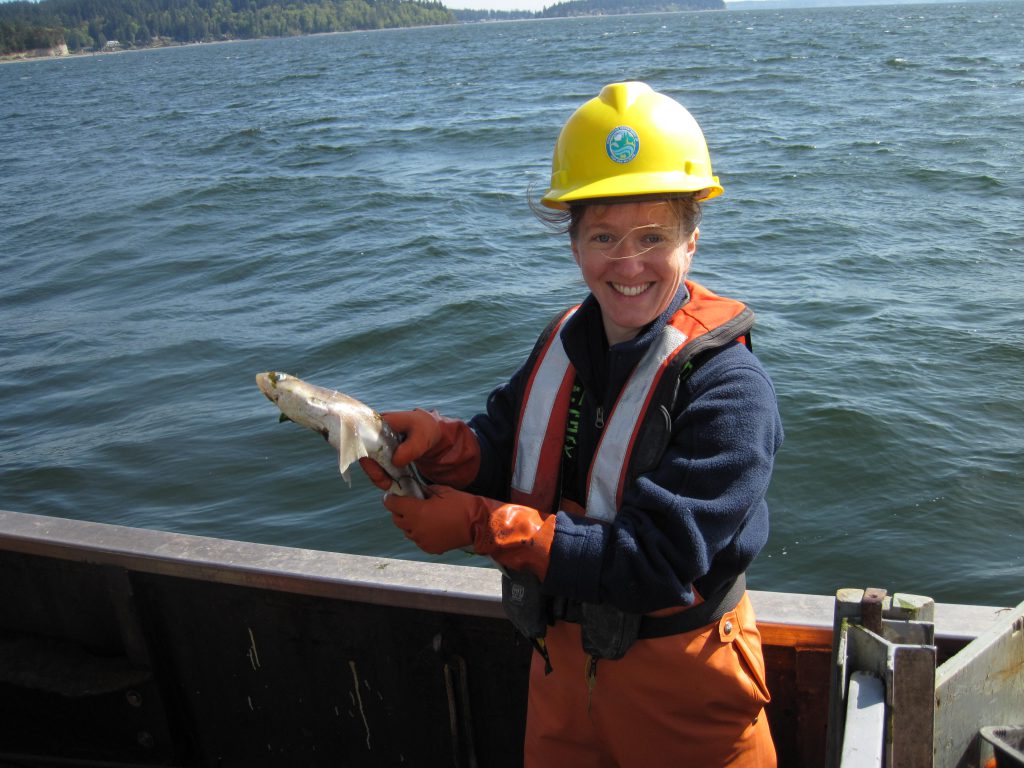
English sole in Elliott Bay and Carr Inlet have shown particularly high expression of vitellogenin according to Harding. She said the results from Elliott Bay are consistent with research from the U.K. that shows natural estrogens in human waste, released in sewage overflows, tend to cause this production of vitellogenin. Harding added that what they’ve seen in Carr Inlet is surprising, since it’s a more remote area with lower population density, and one wouldn’t expect large sewage inputs in that part of the Sound.
However, as Harding explained, there are many chemicals that can mimic estrogen, including CECs commonly found in personal care products and other consumer goods.
Harding mentioned a few common chemicals that mimic estrogen: plasticizers like bisphenol A (BPA)—sometimes used in can linings and bottles; triclosan, found in antimicrobial soaps and hand sanitizers; parabens, preservatives found in lotions, shampoos, and other care products; and nonylphenol, used in lubricating oil additives and laundry and dish detergents, among other products.
“Surprisingly, a lot of the legacy contaminants, like PCBs and DDT, can have weak estrogen properties too,” Harding said. “So if you get enough of those things in combination, it can be a real soup of chemicals that are having these effects.”
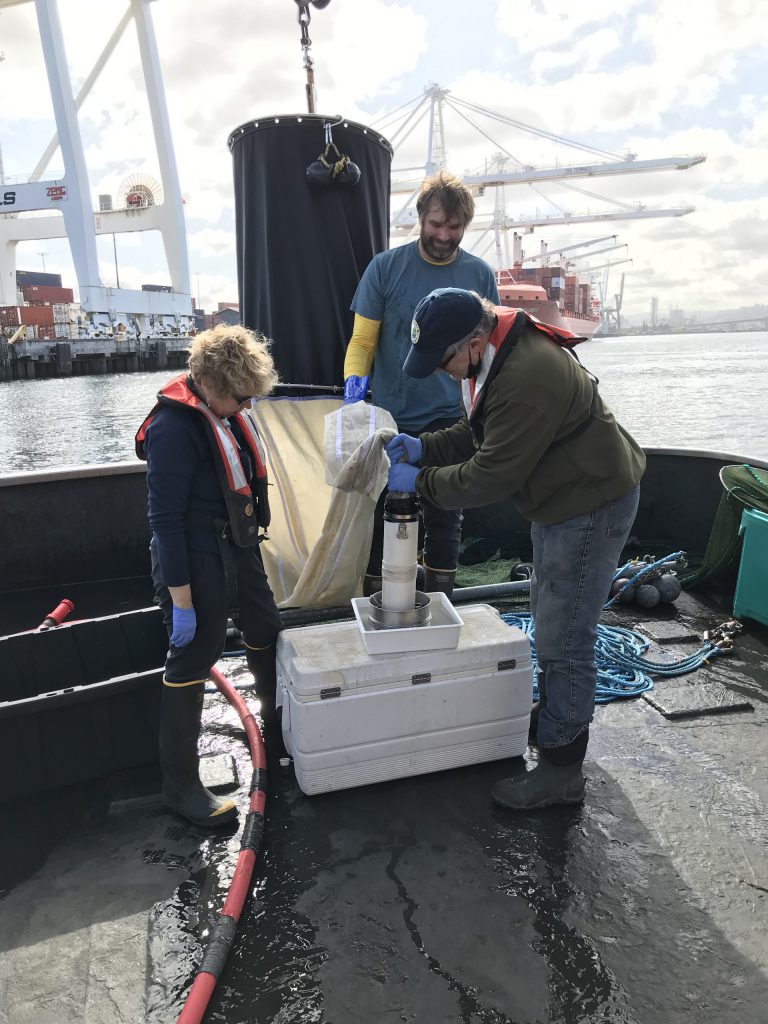
Restoration and reduction success
West once had a boss who said his team only delivered bad news, but West stresses that there’s plenty of good news, too.
With English sole, there’s been a marked reduction in liver disease from exposure to PAHs at six sites throughout the Sound: Everett, Eagle Harbor (Bainbridge Island), the Seattle Waterfront, the Duwamish River, Anderson Island, and Tacoma City Waterway. For some of these sites, like Tacoma’s Commencement Bay and Thea Foss Waterway, targeted cleanup and remediation of PAHs in the sediment has improved the habitat. For the other sites, the TBiOS team thinks the removal of creosote-soaked pilings—by the Washington State Department of Natural Resources and other groups—has had a big effect on reducing PAHs.
The work of the TBiOS team has directly led to better health outcomes for fish too. Carey spoke about a juvenile Chinook salmon project that she worked on with another TBiOS team member, Sandie O’Neill, senior research scientist, in the Snohomish River system.
“We found natural-origin Chinook were accumulating PBDEs in the lower mainstem estuary portion of the Snohomish, and we knew we were collecting them near a wastewater treatment outfall,” Carey said. “We published the results of our study and now we are working with Long Live the Kings, Snohomish County, the Tulalip Tribe, the City of Everett, and Ecology to figure out how to address the problem. The wastewater treatment plant has now detoured their effluent to a different outfall in deeper water, so they can avoid releasing their effluent into the Snohomish estuary when juvenile salmon are migrating. It’s a great success story of using science to inspire action and protect salmon.”
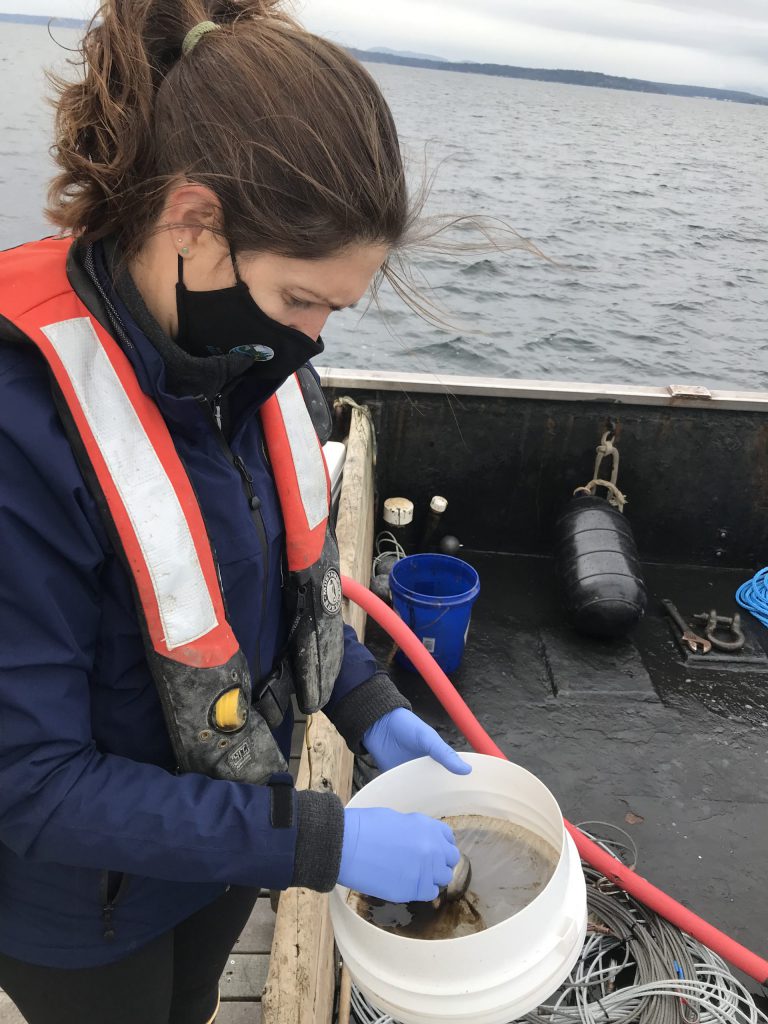
How we can help reduce toxics in aquatic life
The 2022-2026 Action Agenda includes a number of strategies and actions that, when implemented, will reduce contaminant levels in Puget Sound aquatic life. These strategies include:
- creating better oil spill prevention and safety and improving spill response readiness;
- investing in research to support Puget Sound recovery;
- managing stormwater runoff and legacy contamination;
- preventing toxic chemical pollution and promoting the use of safer alternatives; and
- reducing and preventing pollution from wastewater systems, among others.
Derek Day, Stormwater Strategic Initiative Lead with the Washington State Department of Ecology, emphasized that careful planning has gone into defining the key opportunities for addressing toxics in aquatic life. “Partners and technical experts have worked for years to articulate the most strategic approaches to address these issues,” said Day. “The strategies in the Action Agenda draw from work by the Strategic Initiative Leads and many other partners and spotlight where we need to focus and align our efforts – and how we need to adapt those efforts over time.”
“I think we’re on the right track and a lot’s been done in the past two decades. We need to stick with it and keep moving forward, keep doing the good work.” — Andrea Carey
Carey emphasized that the issue of toxics in aquatic life is so complex that we will need to carry out all the strategies to make a difference for aquatic species. “It has to be a multi-pronged approach,” she said. “We see different chemicals accumulating in these animals at different sites, and it varies across the Sound, so the strategy to recover the area will depend on what we’re measuring in the organisms.”
As for what people can do on their own to help, West, Harding, and Carey had similar recommendations. They all said the actions outlined by Puget Sound Starts Here were a great place to start. Make sure your car doesn’t have any leaks, because those leaks contaminate stormwater runoff, which often flows into the Sound. Avoid using pesticides in your yard care, since those chemicals may end up in our waterways and affect aquatic life.
Pharmaceuticals are a big source of endocrine-disrupting chemicals, and so using a pharmacy’s drug take-back program can ensure the chemicals in medicines do not end up in wastewater and eventually the Sound.
Harding also highlighted recent efforts to manage sewage waste on a hyper-local level throughout the country. “I’m intrigued when there are new technologies for how we’re dealing with our waste,” she said. “Some of our waste is really nutrient-rich and can be used for fertilizer. It’s a weird thing that keeps me optimistic.”
Staying optimistic is key with this work, which Carey stressed is a long-haul effort. “It’s a pretty daunting problem that we need to figure out how to fix—the health of Puget Sound is at stake,” she said. “I think we’re on the right track and a lot’s been done in the past two decades. We need to stick with it and keep moving forward, keep doing the good work.”

